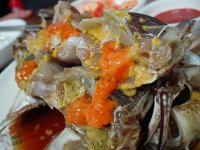Tomalley (from the Carib word tumale, meaning a sauce of lobster liver)[1] or lobster paste is the soft, green substance found in the body cavity of lobsters, that fulfills the functions of both the liver and the pancreas. Tomalley corresponds to the hepatopancreas in other arthropods. It is considered a delicacy, and may be eaten alone but is often added to sauces for flavour and as a thickening agent. The term lobster paste or lobster p穰 can also be used to indicate a mixture of tomalley and lobster roe. Lobster bisque, lobster stock, and lobster consomm are made using lobster bodies (heads), often including the lobster liver.
The hepatopancreas of a crab is also called tomalley; in crabs the tomalley is yellow or yellow-green in colour.[2][3][4] In Maryland and on the Delmarva Peninsula, the hepatopancreas of the blue crab is called the "muster" or "mustard", probably because of the yellow colour, which is not the bright yellow of regular prepared yellow mustard, but closer to one of the brown mustards, such as Dijon mustard. Particularly when eating steamed or boiled crabs, it is considered a delicacy.
The tomalley in general can be consumed in moderation (as with the livers of other animals). It can, however, contain high levels of PCBs which can give a number of negative health effects in large concentrations. It may also contain toxins that are associated with paralytic shellfish poisoning (saxitoxin and gonyautoxin). Those toxins do not leach out when the lobster is cooked in boiling water. The toxins responsible for most shellfish poisonings are water-insoluble, heat and acid-stable, and thus are not diminished by cooking.

